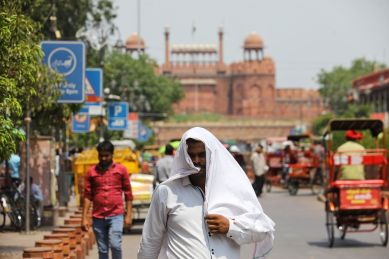Stay updated with the latest - Click here to follow us on Instagram
Hotter nights and muggy days: Why Delhi has been feeling warmer over the years
The analysis used satellite imagery to determine that the city’s built-up area has increased from 467.8 sq km in 2003 to 568.9 sq km in 2022.

Why have you been feeling hotter on summer days?
An analysis by the Centre for Science and Environment (CSE) — which used temperature and humidity data from the IMD — shows there has been an increase in humidity levels over the past 10 summers, how land surface temperatures are cooling down to a smaller extent at night, and how built-up area has increased.
monthly limit of free stories.
with an Express account.
On Monday, the city recorded heatwave conditions with a maximum temperature of 45.1 degrees Celsius. The highest maximum temperature recorded during the day was 48.8 degrees in Northwest Delhi’s Mungeshpur. Heatwave conditions are set to persist till Thursday, going by the India Meteorological Department (IMD) forecast.
According to the CSE analysis, Delhi’s ambient air temperature “shows little change” over the past 10 summers compared to the 2001-2010 decade. However, the “nature of heat is changing” with a significant increase in relative humidity over the past 10 summers.
The analysis considered the months from March to August as summer months, divided into pre-monsoon (March to May) and monsoon (June to August).
The last 10 summers (2014-23) in Delhi have been 8% more humid on average compared to the average relative humidity from 2001-2010. While the average relative humidity for the summers from 2001 to 2010 was 52.5%, in the summer of 2023, this was as high as 60.9%. Similarly, in 2020, it was 61.4%, while it was 57.3% in 2021, and 53.5% in 2022, going by the analysis.
The analysis explains that the combination of high heat and humidity can compromise sweating — the body’s main cooling mechanism. “The evaporation of sweat from the skin cools our bodies, but higher humidity levels limit this natural cooling. As a result, people can suffer heat stress and illness, and the consequences can even be fatal…” it added.
The analysis also considered the ‘heat index,’ a measure of how hot it feels when humidity and temperature are both factored in. “It is considered that a heat index of 41 degrees Celsius is dangerous to human health,” the analysis noted, adding that in the summer of 2023, Delhi recorded 14 days when the daily average heat index crossed the 41-degree mark.
The analysis also said Delhi is “not cooling down at night” – during the summers of 2001-10, the land surface temperature would drop by 12.3 degrees on average from the daytime peak to the nighttime low. Over the past decade, 2014-23, this nighttime cooling has fallen to an average of 11.2 degrees Celsius, and has been even lower in recent years – 9.8 degrees in 2023.
“Hot nights are as dangerous as midday peak temperatures – people get little chance to recover from daytime heat if temperatures remain high overnight,” it explained, adding that the city’s ‘core,’ with the higher built-up area and population, is 2.9 degrees Celsius hotter than its peripheries.
The analysis used satellite imagery to determine that the city’s built-up area has increased from 467.8 sq km in 2003 to 568.9 sq km in 2022.